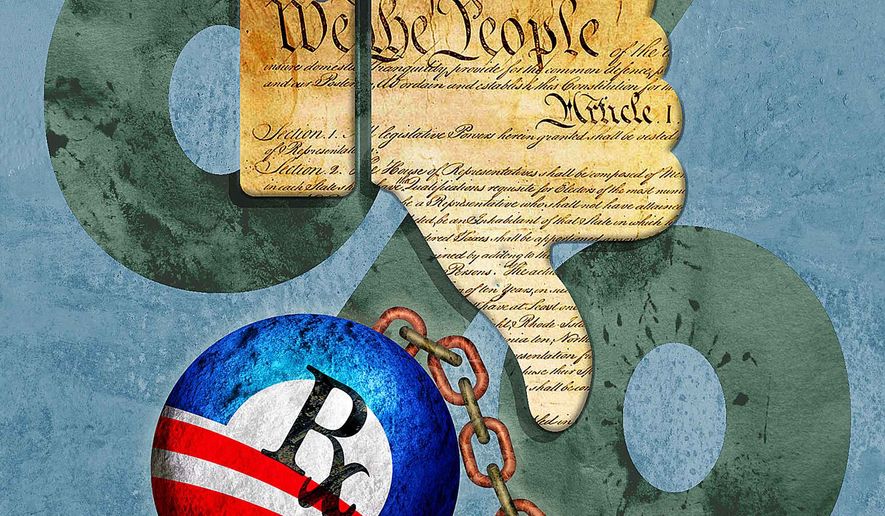OPINION:
Just one week after the Obama administration celebrated the sixth anniversary of the passage of the Affordable Care Act, many people are still shaking their heads at the Supreme Court’s 2012 decision upholding the law’s individual mandate. How could the court decide an unconstitutional financial penalty was somehow legitimate as a “tax”?
As a constitutional historian and former law professor, the question continued to nag me and eventually drew me into the latest of my long series of investigations of the Constitution’s true meaning. That investigation has just been published by Case Western Reserve University Law Review.
After reviewing the historical evidence, here’s what I found: Chief Justice John Roberts’ opinion upholding the Obamacare penalty did not include just one mistake; it included three.
The court admitted if the Obamacare penalty is only a penalty, it should be rejected as an unconstitutional overreach. The Constitution authorizes Congress “To lay and collect Taxes, Duties, Imposts and Excises,” so if the court was right to label the penalty a “tax,” a legitimate argument could be made in favor of the mandate. Was the court correct to treat the Obamacare penalty as a “tax”? Not at all.
When the Constitution uses the word “tax,” it means a financial charge imposed mostly to raise revenue. The Obamacare charge raises a small amount of revenue, but its main purpose is to force people to buy health insurance. For constitutional purposes, that disqualifies it as a tax. Deciding it was a tax was Justice Roberts’ first mistake.
When the Constitution was written, the American Revolution had been over for only four years. The Revolution had been fought largely over the issue of how taxes differed from other impositions. For the court to hold a penalty designed to coerce people is really a “tax” violates a principle our Founders fought for.
The Constitution also says federal laws imposing any “direct Taxes” must be written to split the revenue from the states according to their respective populations. In other words, if Illinois has twice the population of Colorado, then twice the revenue must come from Illinois as comes from Colorado, irrespective of other circumstances.
This constitutional requirement for federal direct taxes is called the “apportionment rule.”
The 16th Amendment abolished the apportionment rule for income taxes but not for other direct taxes.
The Obamacare law didn’t provide for apportionment. Assuming the Obamacare penalty is a tax, would it be direct or indirect? If direct, then the law’s failure to apportion it among the states renders it unconstitutional, and the evidence suggests that’s precisely what ought to have occurred.
Justice Roberts’ opinion for the court shows puzzlement on this issue. Apparently, none of the parties provided the justices with good evidence of what the Constitution means by “direct taxes.” But when the Constitution was written, the division between direct and indirect taxes was well understood. Direct taxes were levies on earning a living (production) and on living itself. Indirect taxes were taxes on consumption and certain other transactions.
Specifically, direct taxes included not just income taxes, but also levies on property and businesses. They further encompassed “capitations,” or head taxes. These were charges just for living in a community.
Indirect taxes included taxes on imports and levies on exports and on certain special transactions. Indirect taxes also included “excises” — levies on consumption of goods. State and federal sales taxes are examples of excises.
Given these categories, Obamacare’s penalty is obviously direct. It is imposed on uninsured people just for being in the country. Thus, it should have been apportioned according to the Constitution’s standards for direct taxes, but it clearly wasn’t.
My third question was: If the Obamacare penalty is a direct tax, then what kind of direct tax is it? The evidence shows it is a head tax — what the Constitution calls a “capitation.” Because the Obamacare penalty can be waived or reduced, Justice Roberts thought it can’t be a capitation — because everyone doesn’t pay the same amount.
That was his third mistake. When the Constitution was written, American tax laws often waived or reduced capitations for people who were poor or who met other criteria. There was no requirement that everyone pay the same.
In sum, the Founding-era evidence shows the Supreme Court erred when it declared the Obamacare individual health insurance mandate is a tax that does not need to be apportioned among the states. The court should have ruled the mandate unconstitutional.
• Robert G. Natelson is a fellow at the Heartland Institute and author of “The Original Constitution: What It Actually Said and Meant.”




Please read our comment policy before commenting.